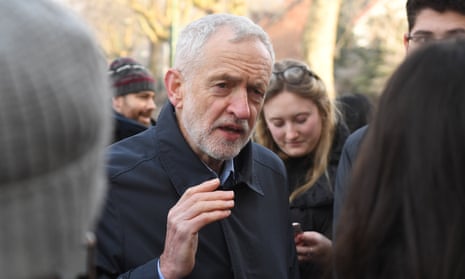Labour party membership has declined by more than 10% from a peak of 575,000 in summer 2017 after Jeremy Corbyn’s stronger-than-expected performance in the general election, according to new figures seen by the Guardian.
The figures, shown to the Guardian by a senior party insider, suggest net membership has declined by around 6,000 in each of the past two months, from 524,000 at the start of December, to 512,000.
That number would still make Labour by far the biggest political party in Britain – approximately four times the size of the Conservatives, whose membership was estimated at 124,000 last spring.
A party spokesman said: “Labour is one of the largest political parties in Europe, made up of over half a million members, who are working to transform our society for the many not the few.”
Turning Labour into a mass “social movement”, that is involved in community activism year-round as well as knocking on doors during election campaigns, is a central part of Corbyn’s project to transform his party.
Labour has vehemently denied a series of news stories in recent days, suggesting the party could face financial difficulties as a result of a drop-off in paying members.
Party insiders insist the overwhelming majority of the 6,000-a-month membership decline is accounted for by “lapsers”: members whose payments have been in arrears for six months.
These show up 18 months after they first signed up for a year-long membership. Surges in membership followed Corbyn’s election as leader in 2015 – under new rules that allowed £3-a-head “supporters” to vote, many of whom subsequently joined up – and his re-election in 2016, party sources suggest.
Another peak came in summer of 2017, when a crowd of tens of thousands at Glastonbury chanted “oh, Jeremy Corbyn!” – and the Guardian understands the 575,000 figure was reported to Labour’s national executive committee at that time.
Setting lapsers aside, more members have joined Labour than resigned during recent weeks. But several MPs claim scores of local activists have become disillusioned and drifted away, as a result of what they regard as the party’s ambivalent stance on Brexit.
The leadership has resisted fierce pressure from grassroots members, who are overwhelmingly pro-remain, to swing its weight behind a second referendum – instead merely suggesting MPs should be given the option of considering a “public vote” to resolve the impasse at Westminster.
Anti-Brexit members were given fresh cause for alarm about Corbyn’s Eurosceptic instincts on Tuesday when a video emerged from 2009 of him referring to the EU as a “military frankesnstein”, which would cement the control of Nato.
Like his mentor Tony Benn, Corbyn was resolutely anti-EU throughout his time as a backbencher; but he backed remain during the 2016 referendum campaign, in part because of the stance of the party’s members.
Concerns about Labour’s record in tackling antisemitism are also cited by some MPs as a reason for disillusionment among grassroots members.
The parliamentary Labour party (PLP) passed a motion on Monday night calling on the leadership “to adequately tackle cases of antisemitism, as failure to do so seriously risks antisemitism in the party appearing normalised and the party seeming to be institutionally antisemitic”.
Corbyn apologised 10 months ago for the “hurt and pain” caused by instances of antisemitism within Labour and pledged to redouble his “efforts to bring this anxiety to an end”.
With Corbyn loyalists now in the majority on the NEC, a series of radical changes to party rules were introduced at last year’s party conference in Liverpool, which are only now starting to work their way through the sprawling organisation.
These included a lowering of the threshold for launching an all-member “trigger ballot” against a sitting MP; and an option for local parties to vote to change their democratic structure to all-member voting.
